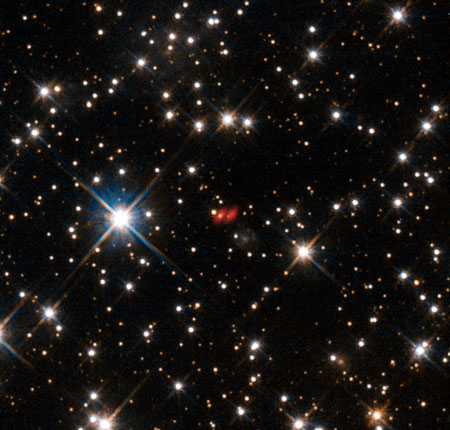| Oct 16, 2013 |
Alma gives astronomers a unique glimpse of a black hole's eating habits
|
|
(Nanowerk News) A team led by astronomers from Chalmers and Onsala Space Observatory have used the powerful telescope Alma to catch an unexpected glimpse of an extreme place in space: the base of a powerful jet close to a distant, hungry black hole.
|
|
There are supermassive black holes — with masses up to several billion solar masses — at the hearts of almost all galaxies in the Universe, including our own galaxy, the Milky Way. In the remote past, these bizarre objects were very active, swallowing enormous quantities of matter from their surroundings, shining with dazzling brilliance, and expelling tiny fractions of this matter through extremely powerful jets. In the current Universe, most supermassive black holes are much less active than they were in their youth, but the interplay between jets and their surroundings is still shaping galaxy evolution.
|
|
A new study, published today in the journal Astronomy & Astrophysics ("Probing the jet base of the blazar PKS1830-211 from the chromatic variability of its lensed images. Serendipitous ALMA observations of a strong gamma-ray flare"), used Alma to probe a black hole jets in a very distant and active object called PKS 1830-211. Light from PKS 1830-211 had to travel for about 11 billion years before reaching us (a redshift of 2.5). The light we see was emitted when the Universe was just 20% of its current age.
|
 |
| The remote active galaxy PKS 1830-211 from Hubble and Alma. (Credit: I. Martí-Vidal)
|
|
In PKS 1830-211, Ivan Martí-Vidal (Chalmers and Onsala Space Observatory) and his team observed a supermassive black hole with a bright and very active jet in the early Universe. It is unusual because its brilliant light passes a massive intervening galaxy on its way to Earth, and is split into two images by gravitational lensing. Einstein’s theory of general relativity predicts that light rays will be deflected as they pass a massive object such as a galaxy. The lensing can create multiple images as well as distort and magnify the background light sources.
|
|
From time to time, supermassive black holes suddenly swallow a huge amount of mass, a star or a cloud of gas and dust, which increases the power of the jet and boosts the radiation up to the very highest energies. And now Alma has, by chance, caught one of these events as it happens in PKS 1830-211.
|
|
"The Alma observation of this case of black hole indigestion has been completely serendipitous. We were observing PKS 1830-211 for another purpose, and then we spotted subtle changes of colour and intensity among the images of the gravitational lens. A very careful look at this unexpected behaviour led us to the conclusion that we were observing, just by a very lucky chance, right at the time when fresh new matter entered into the jet base of the black hole," says Sebastien Muller, a co-author of the paper.
|
|
The team also looked to see whether this violent event had been picked up with other telescopes and were surprised to find a very clear signal in gamma rays, thanks to monitoring observations with the Fermi-LAT satellite. The process that caused the increase of radiation at Alma’s long wavelengths was also responsible of boosting the light in the jet dramatically, up to the highest energies in the Universe. This energy is emitted as gamma rays, the shortest wavelength and highest energy form of electromagnetic radiation.
|
|
"This is the first time that such a clear connection between gamma rays and submillimetre radio waves has been established as coming from the real base of a black hole's jet," adds Sebastien Muller.
|
|
The observations are just the start of Alma's investigations into the workings of jets from supermassive black holes, near and far. The unique object PKS 1830-211 is expected to be the focus of much future research with Alma and other telescopes.
|
|
"There is still a lot to be learned about how black holes can create these huge energetic jets of matter and radiation," concludes Ivan Martí-Vidal. “But the new results, obtained even before Alma was completed, show that it is a uniquely powerful tool for probing these jets — and the discoveries are just beginning!"
|

